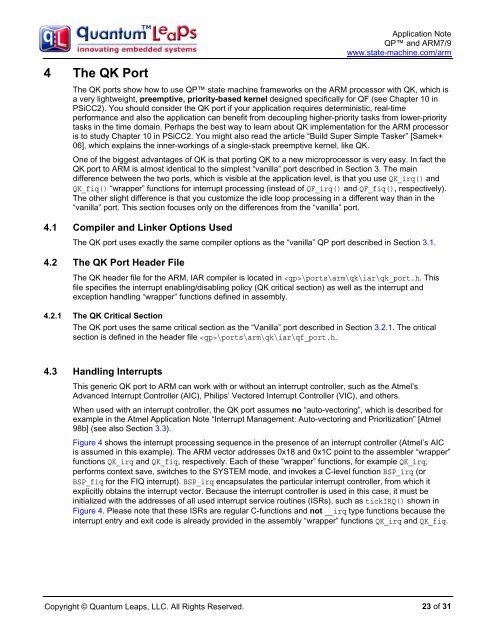AN QP and ARM7/9 - Quantum Leaps
AN QP and ARM7/9 - Quantum Leaps
AN QP and ARM7/9 - Quantum Leaps
Create successful ePaper yourself
Turn your PDF publications into a flip-book with our unique Google optimized e-Paper software.
4 The QK Port<br />
Application Note<br />
<strong>QP</strong> <strong>and</strong> <strong>ARM7</strong>/9<br />
www.state-machine.com/arm<br />
The QK ports show how to use <strong>QP</strong> state machine frameworks on the ARM processor with QK, which is<br />
a very lightweight, preemptive, priority-based kernel designed specifically for QF (see Chapter 10 in<br />
PSiCC2). You should consider the QK port if your application requires deterministic, real-time<br />
performance <strong>and</strong> also the application can benefit from decoupling higher-priority tasks from lower-priority<br />
tasks in the time domain. Perhaps the best way to learn about QK implementation for the ARM processor<br />
is to study Chapter 10 in PSiCC2. You might also read the article “Build Super Simple Tasker” [Samek+<br />
06], which explains the inner-workings of a single-stack preemptive kernel, like QK.<br />
One of the biggest advantages of QK is that porting QK to a new microprocessor is very easy. In fact the<br />
QK port to ARM is almost identical to the simplest “vanilla” port described in Section 3. The main<br />
difference between the two ports, which is visible at the application level, is that you use QK_irq() <strong>and</strong><br />
QK_fiq() “wrapper” functions for interrupt processing (instead of QF_irq() <strong>and</strong> QF_fiq(), respectively).<br />
The other slight difference is that you customize the idle loop processing in a different way than in the<br />
“vanilla” port. This section focuses only on the differences from the “vanilla” port.<br />
4.1 Compiler <strong>and</strong> Linker Options Used<br />
The QK port uses exactly the same compiler options as the “vanilla” <strong>QP</strong> port described in Section 3.1.<br />
4.2 The QK Port Header File<br />
The QK header file for the ARM, IAR compiler is located in \ports\arm\qk\iar\qk_port.h. This<br />
file specifies the interrupt enabling/disabling policy (QK critical section) as well as the interrupt <strong>and</strong><br />
exception h<strong>and</strong>ling “wrapper” functions defined in assembly.<br />
4.2.1 The QK Critical Section<br />
The QK port uses the same critical section as the “Vanilla” port described in Section 3.2.1. The critical<br />
section is defined in the header file \ports\arm\qk\iar\qf_port.h.<br />
4.3 H<strong>and</strong>ling Interrupts<br />
This generic QK port to ARM can work with or without an interrupt controller, such as the Atmel’s<br />
Advanced Interrupt Controller (AIC), Philips’ Vectored Interrupt Controller (VIC), <strong>and</strong> others.<br />
When used with an interrupt controller, the QK port assumes no “auto-vectoring”, which is described for<br />
example in the Atmel Application Note “Interrupt Management: Auto-vectoring <strong>and</strong> Prioritization” [Atmel<br />
98b] (see also Section 3.3).<br />
Figure 4 shows the interrupt processing sequence in the presence of an interrupt controller (Atmel’s AIC<br />
is assumed in this example). The ARM vector addresses 0x18 <strong>and</strong> 0x1C point to the assembler “wrapper”<br />
functions QK_irq <strong>and</strong> QK_fiq, respectively. Each of these “wrapper” functions, for example QK_irq,<br />
performs context save, switches to the SYSTEM mode, <strong>and</strong> invokes a C-level function BSP_irq (or<br />
BSP_fiq for the FIQ interrupt). BSP_irq encapsulates the particular interrupt controller, from which it<br />
explicitly obtains the interrupt vector. Because the interrupt controller is used in this case, it must be<br />
initialized with the addresses of all used interrupt service routines (ISRs), such as tickIRQ() shown in<br />
Figure 4. Please note that these ISRs are regular C-functions <strong>and</strong> not __irq type functions because the<br />
interrupt entry <strong>and</strong> exit code is already provided in the assembly “wrapper” functions QK_irq <strong>and</strong> QK_fiq.<br />
Copyright © <strong>Quantum</strong> <strong>Leaps</strong>, LLC. All Rights Reserved.<br />
23 of 31

















